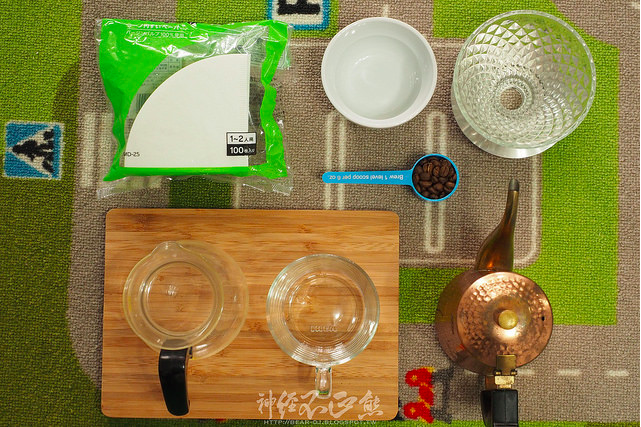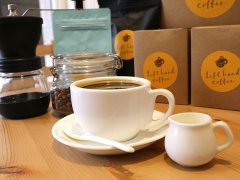The lazyman in the series of hand-brewing coffee has a new method of brewing. Who says that hand-flushing water must be made in circles?

Professional coffee knowledge exchange More coffee bean information Please pay attention to coffee workshop (Weixin Official Accounts cafe_style)
7 Factors That Affect Coffee Making
The new technique that I want to share with you today is something I learned from a bartender who filled up the wind. It is said that this is also the technique that his teacher has been playing recently. This teacher is also an expert who filled up the wind blocking skill.
So in simple terms, what this technique seeks is more like trying to push the limits of complete extraction on a hand-brewed filter cup, or to extract the richness that comes close to being brewed in a corkscrew by hand. The coffee brewed by this method will taste a little heavier than other methods (I mean other methods recorded in my blog), suitable for friends who prefer Japanese coffee taste.
In fact, the equipment does not have to be like these prepared by me, you only need to use the equipment you use easily, the only limit is the conical filter cup, because this method is specially designed for the conical filter cup.
The equipment I have at present is these, so I will use these to fight.
Kalita POT 700
KONO glass pot
IKEA Coffee Glass
KONO MD-25 Acid bleaching filter paper
Driver Diamond filter cup 2--4 persons
Coffee beans + coffee bean spoon
ONEIDA Cup
Of course, there are also some families that are not ready to carry. Similarly, it depends on what tools you have in your hands. Just send that tool to play. The equipment of this technique can not be so particular.
The only thing I couldn't change was the conical filter cup, and I had to find the kind with a faster flow rate, because I didn't have the V60 on hand yet, so I had to use the Driver filter cup first.
There is no limit to the amount of beans, according to your original powder water ratio to adjust, although the weight in the photo is 16.5 grams, but in fact I use less coffee powder, I just want to take this number, otherwise 16.8 can also be. In fact, my own powder-to-water ratio is about 1:17--18, and with a target of 250ml, I only use about 13 or 4 grams of coffee powder.
You can also adjust the ratio of powder to water according to your own taste, because the bartender who taught me, the data of the cup in the store is 23.5 grams of coffee beans for 300ml, and the ratio of powder to water is about 1:12. Anyway, the main point is the idea and concept of brewing in this way. Other parameters can be adjusted by themselves.
As for the brewing water temperature, when I cook very shallow baking, the water temperature will be 93℃ (because the kettle has just boiled and poured directly into the unpreheated Kalita POT700 is this temperature), to the end of the first burst beans will usually use 89℃, hit the second burst beans only 85℃, after the second burst intensive will only be below 80℃.
The above water temperature is only a rough value, in fact, most of the time when I brew is almost OK. You may have your own custom parameter settings, so just run according to your custom data.
The scale can also be adjusted by myself. Originally, I used 6 or 5.5 when I was rushing. Since I changed to play this method, the scale has returned to 3.5 instead.
It's really getting better and better. This is the scale I used when I first started flushing my hands. XD
I haven't had coffee in years XD.
The basic idea of this technique is that in the brewing process, the flavor of the whole cup is first made in the steaming stage, unlike other common methods of steaming, which only wet the coffee powder first. The flavor is brought out layer by layer in the subsequent water injection process (so they have to pay attention to when to cut off the water and pay attention to the subsequent water injection method).
The steaming process takes a long time, and then you need to use your senses (mainly eyes and nose) to confirm the state of the coffee powder after exposure to hot water. As the coffee powder encounters hot water, it will continue to float out of the taste to confirm.
Just as you would in a corkscrew, carefully identify the flavor changes as the coffee is heated in the pot. When you use this technique, also note the flavor development curve of the coffee beans when heated (if it can be drawn as a curve:P), and start pouring water when your coffee has developed the flavor you want. Simply put, when you steam, you make the flavor you want, and the rest is just filtered out with hot water.
After the flavor you want develops, use the conical filter cup to pass through the water faster, so that the coffee flavor is completely dialyzed by the hot water. Therefore, although it is said that as long as it is a conical filter cup, but if it is a faster flow rate V60 or my Driver diamond filter cup, the effect will be better.
For example, in the film, Bankofat (touch two explosions, beans at 220℃), when it first encounters hot water, it will taste like Earl milk tea, then slowly appear with peach sweetness, and finally caramel sweetness caused by baking. The water injection point I grabbed after steaming was when the sweetness of the peaches slowly turned to caramel sweetness.
After the water injection is actually just a simple back and forth drawing a word, this technique and the common "Zhi" word water injection is not the same, because of the difference in the filter cup structure, basically this is the ladder-type filter cup will use the technique. If the common "ó" word injection method is not deliberately stirred, the fine powder is easy to get stuck at the bottom of the filter cup, and this water injection method will make the fine powder naturally be stirred up and not stuck at the bottom of the filter cup.
As long as you draw one back and forth, it is easier to maintain stability in terms of water injection stability than water injection with the word "Zhi". As for whether to pull the water line or whether to cut off the water, in fact, it has little effect on the overall flavor, because the taste that really should be extracted has already been decided to be completed when steaming, and the subsequent water injection only pulls out the level. Even if you pull the powder water ratio to 1:20, the taste will not be too watery.
This lazy man's hand-punching method, conceptually speaking, is not the same as the traditional hand-punching method, which slowly brings out the flavor layer by layer, right?
Now I still occasionally use the word "о" to make coffee, but more often I will switch to this method to brew, because this method is too lazy. Anyway, the main point of this technique was to confirm whether the coffee flavor had developed well before adding water after steaming.
Not yet on the wait, good on the start of water injection, so simple.
In the cup I took as a sample, the front part was very clear berry sweetness, and the middle part was the perfect combination of Colombia and Mantenin bitter sweetness. Instead, I felt that what was different was the berry flavor that was originally in the front, and secretly came out at the end.
But when I tried the same beans at home, even under the same parameters, the overall taste went to the end, and the berry flavor that should have been very bright was covered by chocolate, which proved that I tried cooking and steaming too much at home.
Finally, I would like to add this paragraph to explain that the flavor of coffee determines the time point of water injection after steaming. If you overdo it when steaming, the taste will run to the sweet feeling of the end. If you also have this result, you may have to adjust the timing of water injection like me.
This technique is the pursuit of "bitter but not burnt" cup feeling, that is, in the challenge of the edge of the perfect extraction.
What we call "over-extraction" is not too much of a problem for this genre. In their philosophy, if the beans do not taste bad at the baking stage, then "over-extraction" and "under-extraction" are just a matter of whether the taste is acceptable or not, and does not necessarily mean that they will cook something bad.
For them, the over-extraction should perhaps be subdivided into the balance of flavors in the taste. When the balance tilts in a certain direction, there should be enough ability to adjust the cup feeling back.
As for how to adjust, it depends on personal skills!
。
Important Notice :
前街咖啡 FrontStreet Coffee has moved to new addredd:
FrontStreet Coffee Address: 315,Donghua East Road,GuangZhou
Tel:020 38364473
- Prev

Manual coffee process explanation: hand coffee step diagram steaming hand coffee 15g how much water?
Professional coffee knowledge exchange more coffee bean information please pay attention to the coffee workshop (Wechat official account cafe_style) the seven factors affecting hand-brewed coffee, the process is more time-consuming and exquisite, but the brewed taste is very unforgettable and resistant. welcome to Qianjie coffee to operate and experience, you will know deeply.
- Next

How much water are you still bothering to make 15g or 20g of coffee? Make coffee by hand, make lazybones for five minutes.
Professional coffee knowledge exchange more coffee bean information please pay attention to the coffee workshop (Wechat official account cafe_style) seven factors affecting hand-brewed coffee hand-brewed coffee seems to be a very esoteric art. Well, indeed, the editor has no intention of packaging it as a simple and special thing, because it is really complicated to study, such as the grinding degree of coffee beans, the time of brewing, and water injection.
Related
- Beginners will see the "Coffee pull flower" guide!
- What is the difference between ice blog purified milk and ordinary milk coffee?
- Why is the Philippines the largest producer of crops in Liberia?
- For coffee extraction, should the fine powder be retained?
- How does extracted espresso fill pressed powder? How much strength does it take to press the powder?
- How to make jasmine cold extract coffee? Is the jasmine + latte good?
- Will this little toy really make the coffee taste better? How does Lily Drip affect coffee extraction?
- Will the action of slapping the filter cup also affect coffee extraction?
- What's the difference between powder-to-water ratio and powder-to-liquid ratio?
- What is the Ethiopian local species? What does it have to do with Heirloom native species?

